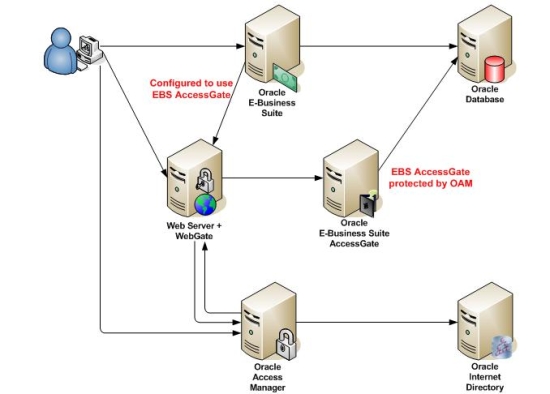For those of you to whom I had the pleasure of speaking at Oracle OpenWorld last week, I promised you would likely see good news by the time you returned home from the conference. Never one to miss out on making people smile, I am happy to announce that Oracle Access Manager 11g Patchset 1 (OAM 11.1.1.5) is now certified for use with Oracle E-Business Suite Release 12.
As with our original 11g certification, there are two possible ways to integrate with Oracle Access Manager 11g.
First Time Users and Existing Users
If you are implementing single sign-on for the first time, or are an existing OAM 11g user, you may integrate with Oracle Access Manager using OAM WebGate and the Oracle E-Business Suite AccessGate Java application, which has now been upgraded to version 1.1.1.0.

The new version of EBS AccessGate contains bug fixes and enhancements over 1.1.0.0. As always, this component is free of charge for licensed EBS customers.
The architecture remains exactly the same as it was for Oracle Access Manager 11.1.1.3, so if you have already integrated EBS with OAM 11.1.1.3, the upgrade will be very quick and straightforward.
Users Upgrading from Oracle Single Sign-On Server 10g
If you are currently using Oracle Single Sign-On Server 10g (OSSO 10g) with E-Business Suite Release 12.0.6 or later, you may choose to migrate your existing single sign-on infrastructure to OAM 11g PS1. In this scenario, you will continue to use the mod_osso agent for authentication against OAM, and no changes are required to your Oracle E-Business Suite or other partner applications. This is a great way to quickly migrate from OSSO 10g, but this approach is only available if you have already implemented single sign-on for EBS using OSSO 10g.

If you are still using OSSO 10g, now is definitely the time to migrate to OAM 11g. At the time of this writing, OSSO 10g is scheduled to drop into sustaining support at the end of this year — less than three months from now. This migration can be done very quickly and with minimal impact. If you had problems with the migration to OAM 11.1.1.3, we have found that most of those issues are fixed in OAM 11.1.1.5, and the process is now much smoother.
The Latest and Greatest
We strongly recommend all OAM 11.1.1.3 users upgrade to this release at their earliest convenience, as this first OAM patchset includes many enhancements and stability fixes that greatly improve the Oracle E-Business Suite integration, especially if you are using Microsoft Active Directory or Windows Native Authentication.
In addition, we recommend applying BP01 (11.1.1.5.1) for the latest set of fixes which have also been validated with Oracle E-Business Suite.
Oracle Access Manager 10gR3
If you are among those customers who are still using OAM 10g with Oracle E-Business Suite, while waiting for a more direct migration to OAM 11g, there’s good news for you, too. The latest release of E-Business Suite AccessGate, version 1.1.1.0, is now certified for use with OAM 10g, and brings the same fixes and enhancements — including a new and improved global logout architecture — to your environment, as well.
However, if you are on Release 11i, we still have no plans at this time to certify OAM 11g with that release. Hopefully your plans to upgrade to 12.1.3 are well underway by now.
Requirements
The requirements for OAM 11.1.1.5 integration are otherwise the same as for our earlier OAM 11.1.1.3 integration:
- Oracle E-Business Suite Release 12.1 RUP 1 (12.1.1) or higher; or Release 12.0 RUP 6 (12.0.6)
- Oracle Access Manager 11g PS1 (11.1.1.5), with BP01 (11.1.1.5.1) recommended
- Oracle Internet Directory 11g PS2 (11.1.1.3) or higher; PS4 (11.1.1.5) recommended
- Oracle WebLogic Server 11g (10.3.1) or higher, if using Oracle E-Business Suite AccessGate; PS4 (10.3.5) recommended
Note that Oracle Internet Directory 11g PS4 (11.1.1.5) is also certified, if you prefer to keep your identity management and access management tools at the same level.
References
For more information, refer to our My Oracle Support documents detailing the various integrations:
- Integrating Oracle E-Business Suite with Oracle Access Manager 11g using Oracle E-Business Suite AccessGate (Note 1309013.1)
- Migrating Oracle Single Sign-On 10gR3 to Oracle Access Manager 11g with Oracle E-Business Suite (Note 1304550.1)